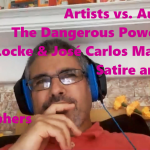
Aesthetics for Distant Birds:
An Online Workshop Series
First Meeting – “Aesthetics, Ethics, and Politics”
Co-organizers: Aaron Meskin, Jonathan Neufeld, Thi Nguyen, and Alex King (that’s me)
If you missed the previous workshop (schedule here), you’re in luck! We recorded it! You can watch the whole thing below or on YouTube. The order of presentations is included below with timestamps. (And, um, sorry for the abrupt start – turns out remembering to hit record at the right time is hard.)
[youtube https://www.youtube.com/watch?v=Yqd7Dlq2gwA&w=560&h=315]
00:00 – “Artists vs. Audiences: When Audiences Attempt to Reinvent Artworks”
James Harold (Mount Holyoke)
Abstract: Bad fans (Emily Nussbaum’s term) and oppositional spectators (bell hooks’ term) both engage with popular works of art in ways that are morally at odds with the best interpretation of those works. The difference between the two groups is a moral one: oppositional spectators are attempting to improve these works morally, and bad fans want to make them morally worse. However, both groups are guilty of a little-recognized aesthetic offense. The aims of this paper are to analyze both bad fans and oppositional spectators, show what is wrong with both, and show why the oppositional gaze is nonetheless justified.
20:55 – “Personal Ideals, Transformations, and the Dangerous Power of Art”
Antony Aumunn (Northern Michigan)
Abstract: This paper explains how art inspires transformations. Transformations are hard to inspire for two reasons. First, they involve adopting new perspectives—ones we can’t fully understand beforehand. Second, they involve coming to care about things we don’t already care about. Art can help with both problems. First, art can offer us glimpses into what it would be like to live in other ways. Second, art can attract us to values we currently reject. Yet, what makes art powerful also makes it dangerous. Transformations aren’t always for the good, and art’s ability to inspire them can be put to immoral ends.
41:23 – “Two Aesthetic Philosophies Born of Struggle: Alain Locke and José Carlos Mariátegui”
Sergio Gallegos Ordorica (John Jay)
Abstract: In this paper, I juxtapose the aesthetical views of Alain Locke and José Carlos Mariátegui to put them in conversation. Indeed, I argue that, in spite of the differences that exist between their intellectual genealogies or their social and geographic locations, there are deep affinities and parallels that hold between their respective views on the nature of art and its emancipatory capacities vis-à-vis oppressed groups such as Amerindians and Blacks. By putting the aesthetical views of Locke and Mariátegui in conversation, I also argue that one can amplify their voices to pursue in a more effective fashion through art various resistance strategies and emancipatory practices against systemic racial oppression across the Americas.
1:01:54 – “The Value of Satire. And Borat.”
Vid Simoniti (Liverpool)
Abstract: Good satires typically attack political positions (i.e. a political class, group, identity or ideology), which merit disparagement. Some satires, however, attack multiple positions, of which not all merit disparagement. Sacha Baron Cohen’s ‘Borat’, for example, derides figures representing American chauvinism, but also the figure of a third world immigrant. The latter, I take it, does not merit disparagement. So, how should we understand the nature of such satires? Do they, cynically, invite us to laugh at the oppressed? Or might they play some more constructive role in the political discourse? I modestly try out the latter option.


